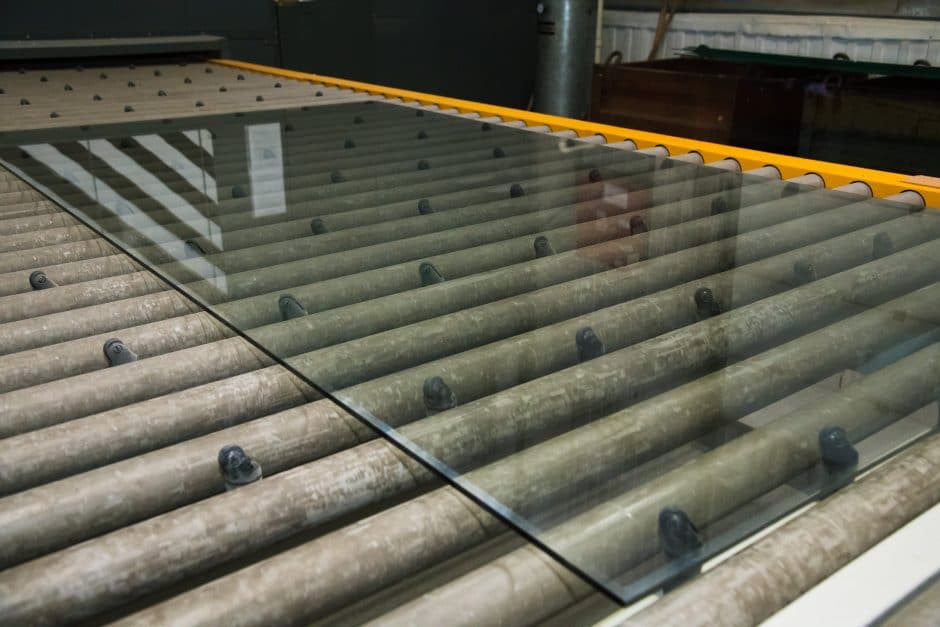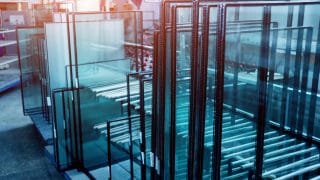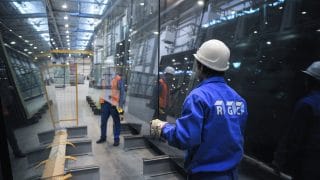
When traditional sheets of glass break, they can become very dangerous. They break into large shards with razor-sharp edges which can easily cut or severely injure someone. And since these sheets of glass aren’t very strong, this can be a major safety concern for vehicle windows, slippery bathroom spaces, and high-rise buildings. Luckily, there is an answer. Tempered glass is stronger and breaks into smaller pieces, making it a safer option for all of the scenarios mentioned above.
What is tempered glass?
Tempered glass is a form of glass that is stronger than typical annealed glass and breaks into smaller pieces. Also known as safety glass, tempered glass is heated and cooled in specific ways to increase its strength and change its composition.
To truly understand tempered glass, it’s important to be familiar with annealed glass. Annealed glass, also known as standard float glass, is glass that has gone through a cooling treatment on a factory’s float line. After pouring and floating atop a tin bath, annealed glass is cooled very slowly to prevent internal stress.
Tempered glass is annealed glass that receives a heat treatment to harden and strengthen it, increasing its strength up to four times. Instead of breaking into large, dangerous shards, tempered glass “spider webs” when it breaks. The entire pane fractures into small pieces with smoother edges, meaning there is significantly less chance of causing an injury.
How is tempered glass made?
Glass manufacturers make tempered glass by heating and then cooling annealed glass. The process creates tension and compression in the glass that makes it stronger but also causes the glass to shatter into small, less-dangerous pieces.
The first step in making toughened glass via tempering is to start with a piece of annealed glass that is already cut to the exact size and shape necessary. Then, the manufacturer heats the annealed glass in a tempering oven until it reaches temperatures over 1,000 degrees Fahrenheit. At that point, the exterior of the glass is cooled rapidly with high-pressure air.
While the exterior surface of the glass is cooling quickly, the manufacturing process prevents the interior from cooling as quickly. The inside of the glass cools slower and begins to pull on the outer layers. This creates tension inside the glass while the outer surface experiences compression—opposing forces that increase the glass’s strength.
This tempering process also causes the glass to shatter into small, rounded pieces when broken. For this reason, it’s impossible to cut and snap sheets of tempered glass as they will shatter completely.
How is tempered glass used?
Due to its safer shattering nature, tempered glass has a lot of practical uses. Essentially, any large sheet of glass that could break and cause injury will typically be safety or tempered glass. Also, any piece of glass that must be strong enough to resist breaking due to impacts should also be tempered. It’s also used in high-heat situations.
- Electrionics. Tempered glass is widely used in hand-held electronic applications including screens on tablets and smartphones. These devices often fall, and users sometimes sit on them, requiring the glass screen to be much stronger and safer than typical annealed glass.
- Cars. There are also automotive uses for tempered glass. The side and rear windows on vehicles are designed to shatter into small pieces to prevent serious injuries in the event of an accident. The front glass is also tempered but features a laminated film to keep the glass together should something hit the windshield, preventing the item from falling on the vehicle occupants.
- Windows and skylights. Large windows on tall buildings where extreme winds or flying objects could send large shards of glass falling are typically tempered glass. These windows are stronger than ordinary annealed glass, and should they break, a shower of small chunks of glass is much less dangerous to pedestrians below. Due to their strength, these tempered windows also prevent the glass from breaking from the inside and folks falling out. The same concept applies to skylights. While these roof-mounted windows must be strong to resist forces, weather, and other hazards, they also need to shatter into small pieces to prevent injuries to building occupants.
- Glass doors. Glass doors on shower and tub enclosures are almost exclusively tempered glass. This prevents slips and falls from becoming life-or-death situations, as folks in the bathroom are much less likely to seriously hurt themselves if they slip and crash through the door.
Advantages of tempered glass
Tempered glass is up to four times stronger than traditional glass. The opposing forces created during the tempering process allow this glass to withstand impacts and weight better than float or plate glass. Manufacturers often laminate pieces of tempered glass together with a film between them to increase their strength even more.
When traditional sheets of glass break, they can become very dangerous. They break into large shards with razor-sharp edges which can easily cut or severely injure someone. And since these sheets of glass aren’t very strong, this can be a major safety concern for vehicle windows, slippery bathroom spaces, and high-rise buildings. Luckily, there is an answer. Tempered glass is stronger and breaks into smaller pieces, making it a safer option for all of the scenarios mentioned above.
What is tempered glass?
Tempered glass is a form of glass that is stronger than typical annealed glass and breaks into smaller pieces. Also known as safety glass, tempered glass is heated and cooled in specific ways to increase its strength and change its composition.
To truly understand tempered glass, it’s important to be familiar with annealed glass. Annealed glass, also known as standard float glass, is glass that has gone through a cooling treatment on a factory’s float line. After pouring and floating atop a tin bath, annealed glass is cooled very slowly to prevent internal stress.
Tempered glass is annealed glass that receives a heat treatment to harden and strengthen it, increasing its strength up to four times. Instead of breaking into large, dangerous shards, tempered glass “spider webs” when it breaks. The entire pane fractures into small pieces with smoother edges, meaning there is significantly less chance of causing an injury.
How is tempered glass made?
Glass manufacturers make tempered glass by heating and then cooling annealed glass. The process creates tension and compression in the glass that makes it stronger but also causes the glass to shatter into small, less-dangerous pieces.
The first step in making toughened glass via tempering is to start with a piece of annealed glass that is already cut to the exact size and shape necessary. Then, the manufacturer heats the annealed glass in a tempering oven until it reaches temperatures over 1,000 degrees Fahrenheit. At that point, the exterior of the glass is cooled rapidly with high-pressure air.
While the exterior surface of the glass is cooling quickly, the manufacturing process prevents the interior from cooling as quickly. The inside of the glass cools slower and begins to pull on the outer layers. This creates tension inside the glass while the outer surface experiences compression—opposing forces that increase the glass’s strength.
This tempering process also causes the glass to shatter into small, rounded pieces when broken. For this reason, it’s impossible to cut and snap sheets of tempered glass as they will shatter completely.
How is tempered glass used?
Due to its safer shattering nature, tempered glass has a lot of practical uses. Essentially, any large sheet of glass that could break and cause injury will typically be safety or tempered glass. Also, any piece of glass that must be strong enough to resist breaking due to impacts should also be tempered. It’s also used in high-heat situations.
- Electrionics. Tempered glass is widely used in hand-held electronic applications including screens on tablets and smartphones. These devices often fall, and users sometimes sit on them, requiring the glass screen to be much stronger and safer than typical annealed glass.
- Cars. There are also automotive uses for tempered glass. The side and rear windows on vehicles are designed to shatter into small pieces to prevent serious injuries in the event of an accident. The front glass is also tempered but features a laminated film to keep the glass together should something hit the windshield, preventing the item from falling on the vehicle occupants.
- Windows and skylights. Large windows on tall buildings where extreme winds or flying objects could send large shards of glass falling are typically tempered glass. These windows are stronger than ordinary annealed glass, and should they break, a shower of small chunks of glass is much less dangerous to pedestrians below. Due to their strength, these tempered windows also prevent the glass from breaking from the inside and folks falling out. The same concept applies to skylights. While these roof-mounted windows must be strong to resist forces, weather, and other hazards, they also need to shatter into small pieces to prevent injuries to building occupants.
- Glass doors. Glass doors on shower and tub enclosures are almost exclusively tempered glass. This prevents slips and falls from becoming life-or-death situations, as folks in the bathroom are much less likely to seriously hurt themselves if they slip and crash through the door.
Advantages of tempered glass
Tempered glass is up to four times stronger than traditional glass. The opposing forces created during the tempering process allow this glass to withstand impacts and weight better than float or plate glass. Manufacturers often laminate pieces of tempered glass together with a film between them to increase their strength even more.
The way tempered glass breaks is a major advantage in regard to safety. Rather than large, heavy shards of glass that could easily cause serious injury, tempered glass breaks into very small pieces. These pieces can still cut someone, but the injuries are typically far less severe.
Disadvantages of tempered glass
The nature of tempered glass to shatter upon sufficient impact is also a disadvantage of tempered glass. It cannot be cut or drilled without shattering. Also, installers have to be very careful when moving sheets of tempered glass as a very slight impact on the edge could cause the entire sheet to shatter.
Another disadvantage of tempered glass is the complete lack of customizability once the sheet is formed. The glass sheets must be cut by the manufacturer prior to tempering, and any modifications such as drilling or shaping must also occur ahead of time. This makes on-site adjustments difficult for installers as any modification will typically shatter the pane.
MT Copeland offers video-based online classes that give you a foundation in construction fundamentals with real-world applications.
Classes include professionally produced videos taught by practicing craftspeople, and supplementary downloads like quizzes, blueprints, and other materials to help you master the skills.



